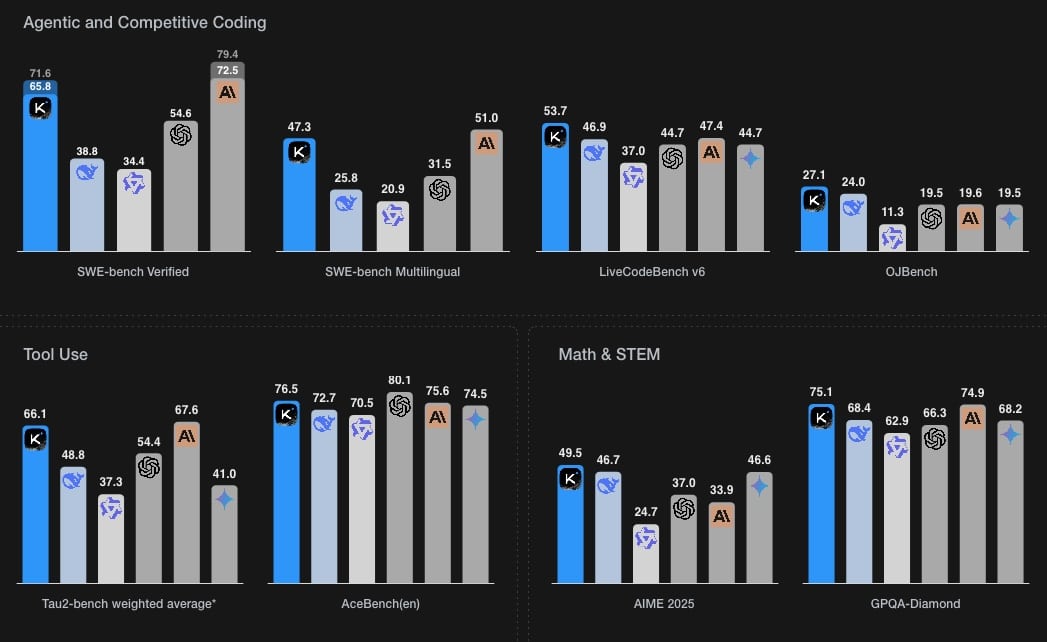Moonshot AI launches an agentic model with a Mixture-of-Experts architecture, outperforming major commercial AI players across multiple benchmarks.
In an increasingly competitive landscape of language models, Kimi K2, the new open-source AI from Moonshot AI with a strong agentic focus, makes a significant impact globally. This model, open for community development, not only rivals systems like OpenAI’s ChatGPT (GPT-4.1) and Google’s Gemini 2.5 Flash but also surpasses them in complex programming, mathematical reasoning, and autonomous tool use.
Agentic intelligence: think, decide, act
Unlike traditional conversational assistants, Kimi K2 has been designed to act. Its agentic approach enables it to understand environments, interact with tools, and perform tasks autonomously. It doesn’t need detailed instructions or predefined workflows—just specify an objective and give it access to necessary tools.
Moonshot AI has demonstrated these capabilities through examples like creating an interactive website with iPython, developing a JavaScript clone of Minecraft, and performing statistical salary analyses based on remote work—generating comprehensive reports, graphs, and personalized recommendations on a ready-to-publish webpage.
Cutting-edge results in programming and mathematics
In terms of technical performance, Kimi K2 leads several key benchmarks:
– LiveCodeBench v6: 53.7% pass@1, surpassing GPT-4.1 (44.7%) and Claude 4 Sonnet (48.5%).
– SWE-bench (Agentic Coding): 71.6% over multiple attempts and 65.8% in a single attempt.
– AIME 2025: averaging 49.5 in mathematical tasks, compared to GPT-4.1’s 37.0.
– GPQA-Diamond: 75.1 average, outperforming all evaluated models.
These results position it as one of the top open-source models globally, especially in programming, scientific reasoning, and mathematics.
Technology behind the model: MoE, MuonClip, and extreme efficiency
Kimi K2 utilizes a Mixture-of-Experts (MoE) architecture with 1 trillion total parameters, of which 32 billion are activated per token. This scalability enhances performance without demanding proportional hardware resources.
The model was trained using Moonshot’s MuonClip optimizer, which improves training stability via qk-clip, a technique designed to prevent attention logit explosions.
Furthermore, its pretraining was highly efficient, processing 15.5 trillion tokens without instability spikes—an industry milestone for large-scale LLM training.
Accessible for everyone: open, versatile, and easy to integrate
Moonshot has released two versions of Kimi K2:
– Kimi-K2-Base: ideal for researchers and developers to fine-tune according to their needs.
– Kimi-K2-Instruct: designed for general tasks and conversational experiences, ready to deploy.
Both are available under open licenses and can be run locally with engines like vLLM, TensorRT-LLM, SGLang, or KTransformers. APIs compatible with OpenAI and Anthropic are also provided, simplifying integration into existing applications.
Beyond the model: agentic data and reinforced training
Kimi K2 is distinguished by its training on large-scale simulated agentic data, created in realistic scenarios where multiple tools and agents collaborate on complex tasks. Such data enables the model to learn skills like code debugging, workflow automation, terminal commands, and experiment analysis with Weights & Biases.
It also employs reinforcement learning in both verifiable tasks and those with subjective rewards, using an internal critique system that enhances performance without requiring continuous human supervision.
Limitations and future roadmap
Despite its impressive achievements, Kimi K2 faces challenges with poorly defined toolsets or complex reasoning, which can lead to lengthy or truncated outputs. Moonshot is working on new versions that will incorporate prolonged thinking and vision capabilities, broadening its application scope.
Kimi K2 is not just a new contender in AI but a representation of a new generation of open, autonomous, and practical models aimed at productivity, science, and development. Its agentic nature, combined with top benchmark performance and open licensing, positions it as a strong, real alternative to the most advanced proprietary models on the market—built to create, reason, and act.
More information at https://moonshotai.github.io/Kimi-K2/.

